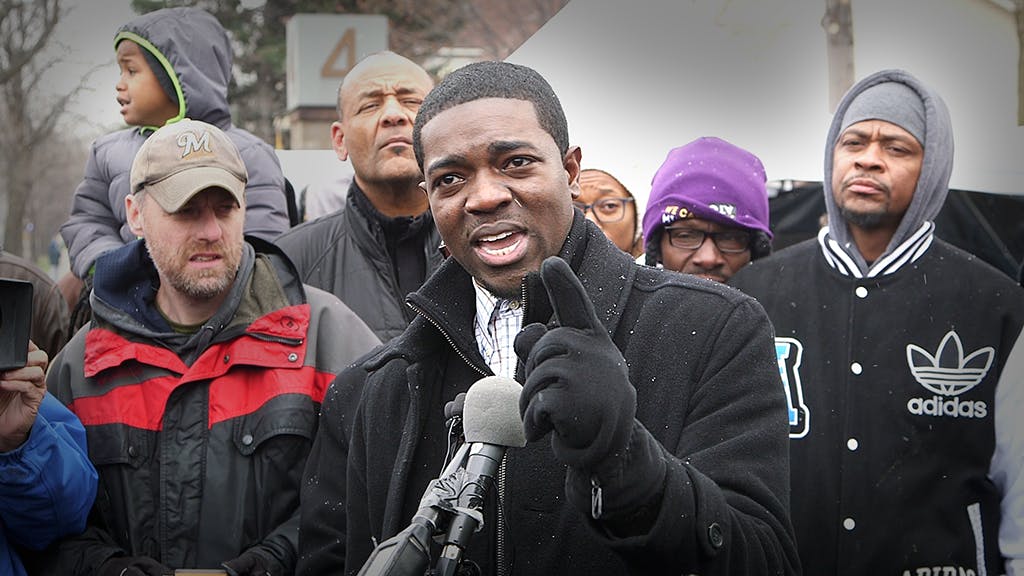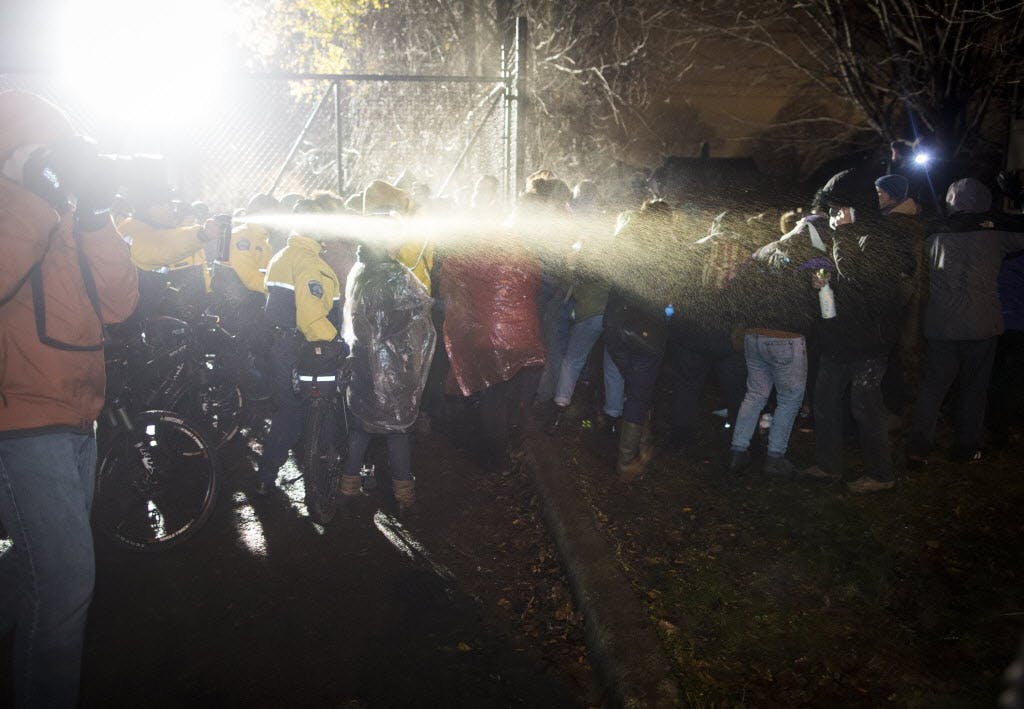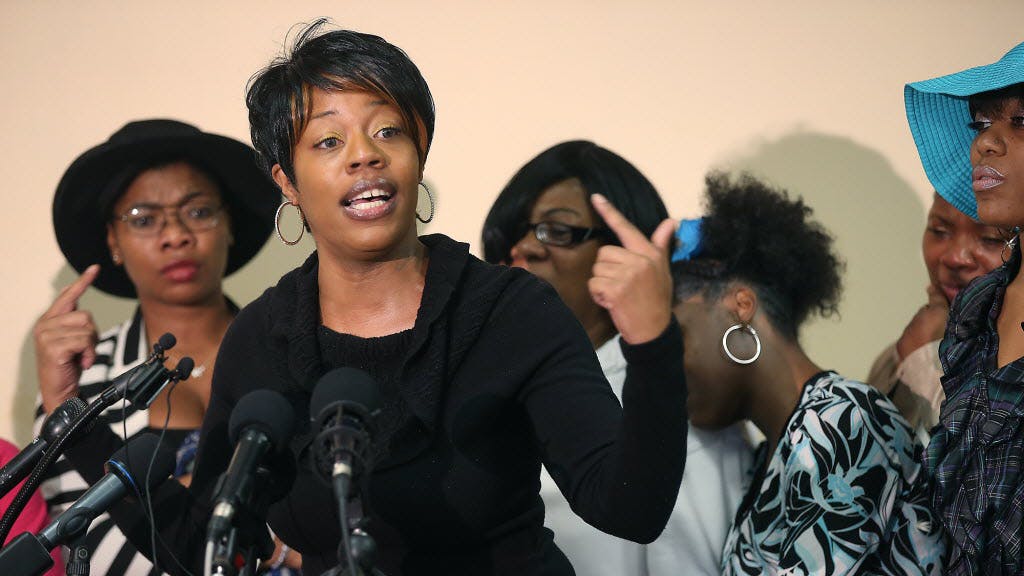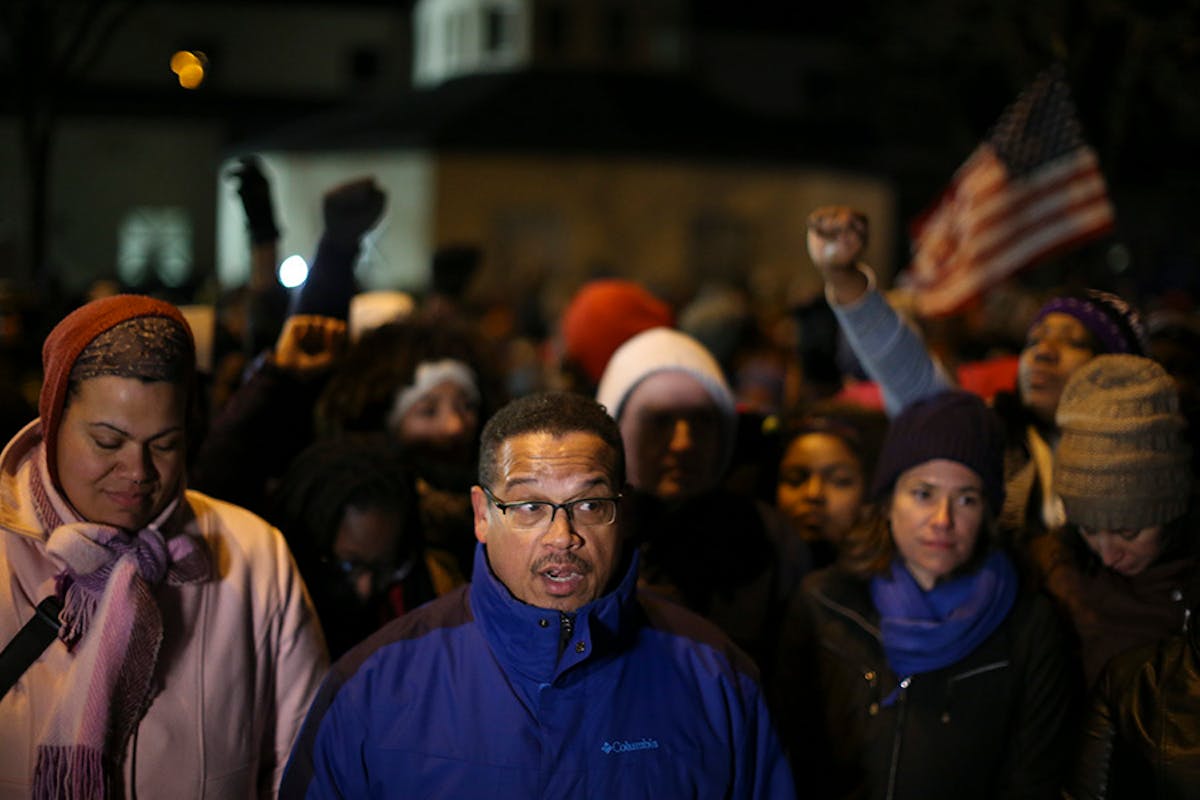With moments of high tension on the fifth night of a vigil at a north Minneapolis police precinct, the head of the national NAACP said Thursday that a "criminal justice crisis" is bringing him to Minneapolis, where he will join with activists angered over the fatal police shooting of Jamar Clark, a black man who was unarmed when he scuffled with police.
Cornell William Brooks, president of one of the nation's oldest and most influential black civil rights organizations, will attend a rally and candlelight vigil at 4:30 p.m. Friday outside the Police Department's Fourth Precinct headquarters, where activists have been maintaining a presence since Clark's shooting a few blocks away early Sunday.
The scene was mostly peaceful Thursday, with a few protesters tagging the police station's walls and windows with profane messages or words supporting Clark. After someone spray-painted over a security camera lens, police gave chase and several protesters followed behind the officers, hands raised in a "don't shoot" posture.
Two men were arrested on suspicion of felony damage to property over the profanity, Minneapolis police said early Friday via Twitter, adding they were the night's only arrests.
The vigil attracted multiple City Council members and U.S. Rep. Keith Ellison, whose district includes north Minneapolis.
Ellison and Council Member Cam Gordon spoke to a crowd of several hundred demonstrators about 7:45 p.m. Both pledged support for the protesters' cause and commended them on pushing public officials to meet some of their demands, including an independent investigation into Clark's death and naming the officers.
In an interview, Ellison said he might not have known the extent of the situation if not for a Star Tribune photo showing officers pointing a weapon at his son Wednesday.
Ellison's adult son and daughter, who live in the area where Clark was shot, have been involved with the protest and want to make sure it stays on track, he said.
Ellison said he's concerned about their safety, but praised Black Lives Matter organizers for trying to keep the situation peaceful. Ellison also spoke about people from outside the community, some of whom have been blamed for rock throwing and other violence during the protests.
"You're going to [have] some people who weren't invited, who don't share the same goals, and that may be distracting," he said. "But I hope the public doesn't get distracted."
The events have grabbed national and global attention.
"We are watching the Minneapolis Police Department," Stephen Green, national youth and college division director for the NAACP, said in a media briefing earlier Thursday outside the police station. "We may be cold, but our hearts are burning for justice."
Brooks said he is "bringing the full weight of the NAACP to bear. This latest incident is one bad chapter in a bad national narrative of police conduct."
He said that the NAACP has been in touch with the U.S. Justice Department about Clark's death and that he wants to meet with Mayor Betsy Hodges and Gov. Mark Dayton while in Minnesota to insist on an "independent, transparent and timely investigation."
"I'm here to lend body and spirit, both moral and legal, to those people on the ground" protesting outside the Fourth Precinct headquarters, he said.
He also wants to see that protesters are given a full opportunity to exercise their free-speech rights and hopes that they do so nonviolently.
Protest disputes
Throughout Thursday, the local NAACP, city leaders and the police union held news conferences to give their versions of Wednesday night's events, when protesters clashed with police and officers forced the activists from in front of the station on Plymouth Avenue N.
Nekima Levy-Pounds, head of the NAACP's Minneapolis chapter, listed abuses that she maintained occurred at the hands of police. She alleged that "two protesters, both women, were beaten in an alley" by police. She said she'd heard that the violence was captured on video.
Levy-Pounds also alluded to a gun being pointed at Ellison's son. She said three City Council members had a similar experience. "It's hard to tell if these are real guns" or ones that fire something less lethal than bullets, she said.
In response, Police Chief Janeé Harteau said that no such allegations have been brought to her attention. She noted that unruly elements among the 400 or so protesters — some of them "people outside the community" whom she characterized as "anarchists" — hit police with pepper spray and threw objects, including rocks and three Molotov cocktails, at officers.
The chief hoisted a large rock above her head to drive home the point before ticking off the damage: 12 squad cars damaged ($25,000), portable cameras damaged ($13,000) and minor damage to the station's building and fencing. She praised her officers for acting "appropriately and with maximum restraint" under the circumstances.
Hodges said the city is facing something that no community wants to face. She stressed the need to keep officers and the neighborhood safe and requested calm. She said she understands the importance of "hearing everybody's voices" and that "we have many things to get right."
Two longtime North Siders spoke at the mayor's news conference. Ezra Hyland said he saw protesters throwing rocks at officers. Some argued with members of Clark's relatives about "who is his true family," he said.
Ron Edwards, a longtime activist and sometimes critic of City Hall, said city leaders "have developed a plan and are taking every course of action to not allow" Minneapolis to be torn apart by the same unrest over police shootings that recently scarred other American cities.
The officers involved in Clark's death, Mark Ringgenberg, 30, and Dustin Schwarze, 28, are on paid leave.
Under investigation
Lt. Bob Kroll, president of the police union, offered more specifics Thursday about the fatal shooting, saying the officers told a union attorney that Clark spun one officer's gun belt and had "manual control" of the weapon by the handle.
"Mr. Clark was given multiple opportunities to desist," Kroll said. "Instead, he chose to engage officers in a life-or-death struggle for an officer's weapon."
An autopsy showed Clark died of a gunshot to the head.
Before the shooting, Clark had an altercation with a woman, and her ankle was broken, Kroll said.
The state Bureau of Criminal Apprehension said it has several videos of the shooting but none showing the event in its entirety. The videos will not be released until the investigation is finished, it said.
Staff writer Liz Sawyer contributed to this report.
david.chanen@startribune.com 612-673-4465
paul.walsh@startribune.com 612-673-4482

Prairie Island Indian Community requests the return of 'Mankato Hanging Rope'




